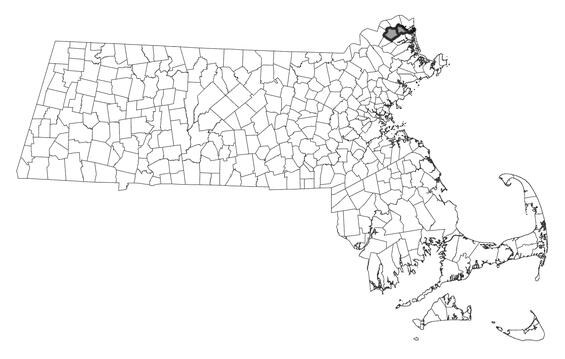- Scientific name: Sagittaria montevidensis ssp. spongiosa
- Species of Greatest Conservation Need (MA State Wildlife Action Plan)
- Endangered (MA Endangered Species Act)
Description
Estuary arrowhead is a spongy aquatic member of the water-plantain family (Alismataceae). Like other species in this family, plants are rooted to the substrate with septate roots. The leaves are modified into narrow (4-18 cm; 1.6-7.1 in) long, (0.5-1 cm; 0.2-0.4 in) wide, spongy phyllodia, and the tips of the leaves are slightly expanded and spatula-like (or rarely more sagittate). Erect peduncles bear one to four whorls of white, inconspicuous flowers; flowers may also be solitary. Fruiting heads (1.2-2.1 cm; 0.5-0.8 inches in diameter) are comprised of a cluster of small, flattened achenes, each narrowly winged on the margins and with a short lateral beak.
Estuary arrowhead is the only annual arrowhead species in New England and one of a few arrowheads that occupy tidally-influenced habitats. It is best identified when in flower or fruit. Estuary arrowhead can be recognized by its erect, spongy leaves with spatulate tips. In rare instances, this species may have expanded blades, typically without basal lobes. Inflorescences are supported by thick, relatively short peduncles that are usually shorter than the leaves, and thick, spongy pedicels. The flowers are perfect (at least the lowermost ones), with erect, appressed sepals that enclose the flower and fruiting head. The pedicels become recurved when the flowers mature.
Estuary arrowhead is similar to a few other arrowheads that may occur in tidal waters. River arrowhead (S. subulata) also has bladeless leaves and recurved fruiting pedicels but differs from estuary arrowhead by its longer (to 30 cm; 11.8 in), wider (1-6 mm; 0.04-0.24 in) leaves, longer peduncles, and greater number of flower whorls (up to 10). It has pistillate lower flowers with reflexed sepals in fruit, and achenes with one to three toothed wings on each face. Grass-leaf arrowhead (S. graminea) can have phyllodial leaves but these are not spongy and are long (to 30 cm; 11.8 in) and flattened on top. It also has long peduncles (to 5 dm; 19.7 in), up to 12 flower whorls, pistillate lower flowers with reflexed sepals, and ascending pedicels when in fruit (although this species rarely fruits in our range). Mud arrowhead (S. rigida) has highly variable leaves and may have phyllodial leaves. It differs from estuary arrowhead by its longer peduncle (to 8 dm; 31.5 in), greater number of flower whorls, upper staminate flowers with long pedicels (1.5-3 cm; 0.6-1.2 in), lower pistillate flowers that are nearly sessile, and fruiting pedicels that are ascending, with larger achenes (2-3 mm; 0.08-0.12 in) and reflexed sepals.
Life cycle and behavior
This is an herbaceous annual species.
Population status
Estuary arrowhead is listed under the Massachusetts Endangered Species Act as Endangered. All listed species are protected from killing, collecting, possessing, or sale, and from activities that would destroy habitat and thus directly or indirectly cause mortality or disrupt critical behaviors. MassWildlife’s Natural Heritage & Endangered Species Program database has 7 records from 2 counties: Middlesex and Essex. Two of those records are within the last 25-year period.

Distribution in Massachusetts
1999-2024
Based on records in the Natural Heritage Database
Distribution and abundance
Estuary arrowhead occurs from New Brunswick south along the coast to Delaware and eastern North Carolina.
Habitat
Estuary arrowhead is restricted to sandy shores and mudflats of freshwater and brackish tidal rivers and marshes in coastal areas. Plants are submersed under high tide conditions and exposed during low tides. Species found in association with estuary arrowhead in Massachusetts include grass-leaf arrowhead, perfoliate pondweed (Potamogeton perfoliatus), little spike-rush (Eleocharis acicularis), water purslane (Ludwigia palustris), wild rice (Zizania aquatica), Atlantic mudwort (Limosella australis), estuary beggar-ticks (Bidens hyperborea), Lilaeopsis (Lilaeopsis chinensis), and dotted smartweed (Persicaria punctata).
Healthy habitats are vital for supporting native wildlife and plants. Explore habitats and learn about conservation and restoration in Massachusetts.
Threats
Primary threats to this species are changes to habitat hydrology and sediment regimes, and competition with invasive species.
Conservation
As for many rare species, the exact needs for management of estuary arrowhead are not known. This species occurs in freshwater tidal marshes and stream banks, and any alteration of hydrological conditions or increased sedimentation due to changes in adjacent land use should be avoided. Competition from invasive wetland species could also reduce the available habitat of estuary arrowhead. All active management of rare plant populations (including invasive species removal) is subject to review under the Massachusetts Endangered Species Act and should be planned in close consultation with the MassWildlife’s Natural Heritage & Endangered Species Program.
References
Gleason, H.A., and A. Cronquist. 1991. Manual of Vascular Plants of Northeastern United States and Adjacent Canada, 2nd edition. The New York Botanical Garden, Bronx, NY.
Haines, A. 2011. Flora Novae Angliae – a Manual for the Identification of Native and Naturalized Higher Vascular Plants of New England. New England Wildflower Society, Yale Univ. Press, New Haven, CT.
Contact
| Date published: | May 8, 2025 |
|---|